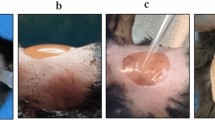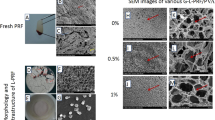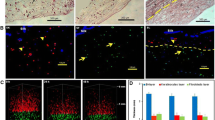Abstract
Fibrin has excellent biocompatibility and biological properties to support tissue regeneration and promote wound healing. However, the role of diluted fibrin in wound healing has yet to be elucidated as it is commonly used in high concentration. This study was aimed to examine the effects of diluted plasma-derived fibrin (PDF) on keratinocyte and fibroblast wound healing in term of cell proliferation, migration, extracellular matrix (ECM) production and soluble factor secretion. Two PDF concentrations, 10 and 20% (v/v) were tested on keratinocytes and fibroblasts indirectly co-cultured in the transwell system. The control group was cultured with 5% FBS. Results showed that PDF reduced the keratinocyte growth rate and fibroblast migration, and increased the fibroblast ECM gene expression whereby significant differences were found between the 20% PDF group and the 5% FBS group. Similar trend was seen for the 10% PDF group but the differences were not significant. Comparison of the soluble factors between the PDF groups demonstrated that the level of growth-related oncogene alpha, interleukin-8 and epithelial neutrophil-activating peptide-78 were significantly higher in the 10% PDF group, whilst interleukin-1 alpha and granulocyte–macrophage colony stimulating factor were significantly more concentrated in the 20% PDF group. Our results suggested that PDF selectively elevated the expression of collagen type 1 and collagen type 3 in fibroblasts but slowed down the migration in concentration-dependent manner. These novel findings provide new insight into the role of PDF in wound healing and may have important implications for the use of fibrin in skin tissue engineering.





Similar content being viewed by others
Abbreviations
- PDF:
-
Plasma-derived fibrin
- TESS:
-
Tissue-engineered skin substitute
- col 1:
-
Collagen type 1
- col 3:
-
Collagen type 3
- FN:
-
Fibronectin
- CLSM:
-
Confocal laser scanning microscope
- angio:
-
Angiogenesis
- RE:
-
Re-epithelialization
- TR:
-
Tissue remodeling
- GTF:
-
Granulation tissue formation
- pro-inflam:
-
Pro-inflammation
- NC:
-
Neutrophil chemotaxis
- MC:
-
Monocyte/macrophage chemotaxis
- IL-1α:
-
Interleukine-1 alpha
- TNF-α:
-
Tumor necrosis factor-alpha
- IL-6:
-
Interleukine-6
- G-CSF:
-
Granulocyte-colony stimulating factor
- GM-CSF:
-
Granulocyte–macrophage colony stimulating factor
- TGF-β:
-
Transforming growth factor-beta
- GRO-α:
-
Growth-related oncogene-alpha
- RANTES:
-
Regulated upon activation, normal T-cell expressed, and presumably secreted
- MCP-1:
-
Monocyte chemoattractant protein-1
- IL-8:
-
Interleukine-8
- ENA-78:
-
Epithelial-derived neutrophil-activating protein 78
- SDF-1:
-
Stromal cell-derived factor-1
- HGF:
-
Hepatocyte growth factor
- VEGF-A:
-
Vascular endothelial growth factor-A
- FGF-β:
-
Fibroblast growth factor-β
- PDGF:
-
Platelet-derived growth factor
- EGF:
-
Epidermal growth factor
References
Bacakova M, Musilkova J, Riedel T, Stranska D, Brynda E, Zaloudkova M, Bacakova L (2016) The potential applications of fibrin-coated electrospun polylactide nanofibers in skin tissue engineering. Int J Nanomedicine 11:771–789
Badillo AT, Chung S, Zhang L, Zoltick P, Liechty KW (2007) Lentiviral gene transfer of SDF-1apha to wounds improves diabetic wound healing. J Surg Res 143:35–42
Bao P, Kodra A, Tomic-Canic M, Golinko MS, Ehrlich HP, Brem H (2009) The role of vascular endothelial growth factor in wound healing. J Surg Res 153:347–358
Barrientos S, Stojadinovic O, Golinko MS, Brem H, Tomic-Canic M (2008) Growth factors and cytokines in wound healing. Wound Repair Regen 16:585–601
Bevan D, Gherardi E, Fan TP, Edwards D, Warn R (2004) Diverse and potent activities of HGF/SF in skin wound repair. J Pathol 203:831–838
Brown LF, Lanir N, McDonagh J, Tognazzi K, Dvorak AM, Dvorak HF (1993) Fibroblast migration in fibrin gel matrices. Am J Pathol 142:273–283
Chen JD, Lapiere J-C, Sauder DN, Peavey C, Woodley DT (1995) Interleukin-1 alpha stimulates keratinocyte migration through an epidermal growth factor/transforming growth factor-alpha-independent pathway. J Investig Dermatol 104:729–733
Chen Y-W, Yin S, Lai Y-JJ, Johnson MD, Lin C-Y (2016) Plasminogen-dependent matriptase activation accelerates plasmin generation by differentiating primary human keratinocytes. J Investig Dermatol 136:1210–1218
Currie LJ, Sharpe JR, Martin R (2001) The use of fibrin glue in skin grafts and tissue-engineered skin replacements: a review. Plast Reconstr Surg 108:1713–1726
Doni A, D’Amico G, Morone D, Mantovani A, Garlanda C (2017) Humoral innate immunity at the crossroad between microbe and matrix recognition: the role of PTX3 in tissue damage. Semin Cell Dev Biol 61:31–40
Drew AF, Liu H, Davidson JM, Daugherty CC, Degen JL (2001) Wound-healing defects in mice lacking fibrinogen. Blood 97:3691–3698
Eming SA, Krieg T, Davidson JM (2007) Inflammation in wound repair: molecular and cellular mechanisms. J Investig Dermatol 127:514–525
Engelhardt E, Toksoy A, Goebeler M, Debus S, Bröcker E-B, Gillitzer R (1998) Chemokines IL-8, GROα, MCP-1, IP-10, and Mig are sequentially and differentially expressed during phase-specific infiltration of leukocyte subsets in human wound healing. Am J Pathol 153:1849–1860
Erol E, Fatih A, Irfan A, Fusun E (2004) Effects of granulocyte-colony stimulating factor on wound healing in a mouse model of burn trauma. Tohoku J Exp Med 204:11–16
Fang Y, Gong SJ, Xu YH, Hambly B, Bao S (2007) Impaired cutaneous wound healing in granulocyte/macrophage colony-stimulating factor knockout mice. Br J Dermatol 157:458–465
Fisher GJ, Shao Y, He T, Qin Z, Perry D, Voorhees JJ, Quan T (2016) Reduction of fibroblast size/mechanical force down-regulates TGF-β type II receptor: implications for human skin aging. Aging Cell 15:67–76
Frank J, Born K, Barker JH, Marzi I (2003) In vivo effect of tumor necrosis factor alpha on wound angiogenesis and epithelialization. Eur J Trauma 29:208–219
Geer DJ, Andreadis ST (2003) A novel role of fibrin in epidermal healing: plasminogen-mediated migration and selective detachment of differentiated keratinocytes. J Investig Dermatol 121:1210–1216
Gillitzer R, Goebeler M (2001) Chemokines in cutaneous wound healing. J Leukoc Biol 69:513–521
Greenhalgh D, Sprugel K, Murray M, Ross R (1990) PDGF and FGF stimulate wound healing in the genetically diabetic mouse. Am J Pathol 136:1235–1246
Heldin C-H, Westermark B (1999) Mechanism of action and in vivo role of platelet-derived growth factor. Physiol Rev 79:1283–1316
Hermans MH (2014) Porcine xenografts vs. (cryopreserved) allografts in the management of partial thickness burns: is there a clinical difference? Burns 40:408–415
Hsieh JY, Smith TD, Meli VS, Tran TN, Botvinick EL, Liu WF (2017) Differential regulation of macrophage inflammatory activation by fibrin and fibrinogen. Acta Biomater 47:14–24
Idrus RBH, Rameli MABP, Cheong LK, Xian LJ, Hui CK, Latiff MBA, Saim AB (2014a) Allogeneic bilayered tissue-engineered skin promotes full-thickness wound healing in ovine model. Biomed Res India 25:192–198
Idrus RH, Bin P, Rameli MA, Low KC, Law JX, Chua KH, Latiff MBA, Saim AB (2014b) Full-thickness skin wound healing using autologous keratinocytes and dermal fibroblasts with fibrin: bilayered versus single-layered substitute. Adv Skin Wound Care 27:171–180
Janmey PA, Winer JP, Weisel JW (2009) Fibrin gels and their clinical and bioengineering applications. J R Soc Interface 6:1–10
Jones JE, Nelson EA (2013) Skin grafting for venous leg ulcers. Cochrane Database Syst Rev 1:CD001737
Jones V, Grey JE, Harding KG (2006) Wound dressings. BMJ 332:777–780
Lin Z-Q, Kondo T, Ishida Y, Takayasu T, Mukaida N (2003) Essential involvement of IL-6 in the skin wound-healing process as evidenced by delayed wound healing in IL-6-deficient mice. J Leukoc Biol 73:713–721
Low QE, Drugea IA, Duffner LA, Quinn DG, Cook DN, Rollins BJ, Kovacs EJ, DiPietro LA (2001) Wound healing in MIP-1α−/− and MCP-1−/− mice. Am J Pathol 159:457–463
Maarof M, Law JX, Chowdhury SR, Khairoji KA, Saim AB, Idrus RBH (2016) Secretion of wound healing mediators by single and bi-layer skin substitutes. Cytotechnology 68:1873–1884
Mazlyzam A, Aminuddin B, Fuzina N, Norhayati M, Fauziah O, Isa M, Saim L, Ruszymah B (2007) Reconstruction of living bilayer human skin equivalent utilizing human fibrin as a scaffold. Burns 33:355–363
O’Connor N, Mulliken J, Banks-Schlegel S, Kehinde O, Green H (1981) Grafting of burns with cultured epithelium prepared from autologous epidermal cells. Lancet 317:75–78
Oragui E, Nannaparaju M, Khan WS (2011) The role of bioreactors in tissue engineering for musculoskeletal applications. Open Orthop J 5:267–270
Ortega S, Ittmann M, Tsang SH, Ehrlich M, Basilico C (1998) Neuronal defects and delayed wound healing in mice lacking fibroblast growth factor 2. Proc Natl Acad Sci USA 95:5672–5677
Park HC, Champakalakshmi R, Panengad PP, Raghunath M, Mehta JS (2011) Tissue adhesives in ocular surgery. Expert Rev Ophthalmol 6:631–655
Petering H, Kluthe C, Dulkys Y, Kiehl P, Ponath PD, Kapp A, Elsner J (2001) Characterization of the CC chemokine receptor 3 on human keratinocytes. J Investig Dermatol 116:549–555
Pierson R, Winn H, Russell PS, Auchincloss H (1989) Xenogeneic skin graft rejection is especially dependent on CD4+ T cells. J Exp Med 170:991–996
Reinertsen E, Skinner M, Wu B, Tawil B (2014) Concentration of fibrin and presence of plasminogen affect proliferation, fibrinolytic activity, and morphology of human fibroblasts and keratinocytes in 3D fibrin constructs. Tissue Eng Part A 20:2860–2869
Rosenkilde MM, Schwartz TW (2004) The chemokine system—a major regulator of angiogenesis in health and disease. APMIS 112:481–495
Salcedo R, Young HA, Ponce ML, Ward JM, Kleinman HK, Murphy WJ, Oppenheim JJ (2001) Eotaxin (CCL11) induces in vivo angiogenic responses by human CCR3+ endothelial cells. J Immunol 166:7571–7578
Seet WT, Maarof M, Anuar KK, Chua K-H, Irfan AWA, Ng MH, Aminuddin BS, Ruszymah BHI (2012) Shelf-life evaluation of bilayered human skin equivalent, MyDerm™. PLoS ONE 7:e40978
Shelton WR, Treacy SH, Dukes AD, Bomboy AL (1998) Use of allografts in knee reconstruction: I. Basic science aspects and current status. J Am Acad Orthop Surg 6:165–168
Shephard P, Martin G, Smola-Hess S, Brunner G, Krieg T, Smola H (2004) Myofibroblast differentiation is induced in keratinocyte-fibroblast co-cultures and is antagonistically regulated by endogenous transforming growth factor-β and interleukin-1. Am J Pathol 164:2055–2066
Thomay AA, Daley JM, Sabo E, Worth PJ, Shelton LJ, Harty MW, Reichner JS, Albina JE (2009) Disruption of interleukin-1 signaling improves the quality of wound healing. Am J Pathol 174:2129–2136
Werner S, Krieg T, Smola H (2007) Keratinocyte-fibroblast interactions in wound healing. J Investig Dermatol 127:998–1008
Xian LJ, Chowdhury SR, Saim AB, Idrus RBH (2015) Concentration-dependent effect of platelet-rich plasma on keratinocyte and fibroblast wound healing. Cytotherapy 17:293–300
Xu X, Zhu F, Zhang M, Zeng D, Luo D, Liu G, Cui W, Wang S, Guo W, Xing W (2012) Stromal cell-derived factor-1 enhances wound healing through recruiting bone marrow-derived mesenchymal stem cells to the wound area and promoting neovascularization. Cells Tissues Organs 197:103–113
Yu A, Matsuda Y, Takeda A, Uchinuma E, Kuroyanagi Y (2012) Effect of EGF and bFGF on fibroblast proliferation and angiogenic cytokine production from cultured dermal substitutes. J Biomater Sci Polym Ed 23:1315–1324
Acknowledgement
This work was supported by Research University Grant (Grant Numbers: DIP-2012-08 and DPP-2013-084) from the Ministry of Higher Education of Malaysia.
Author information
Authors and Affiliations
Corresponding author
Ethics declarations
Conflict of interest
The authors declare that they have no conflict of interest.
Electronic supplementary material
Below is the link to the electronic supplementary material.
Rights and permissions
About this article
Cite this article
Law, J.X., Chowdhury, S.R., Aminuddin, B.S. et al. Role of plasma-derived fibrin on keratinocyte and fibroblast wound healing. Cell Tissue Bank 18, 585–595 (2017). https://doi.org/10.1007/s10561-017-9645-2
Received:
Accepted:
Published:
Issue Date:
DOI: https://doi.org/10.1007/s10561-017-9645-2




